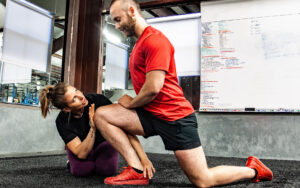Yes, strengthening all the muscles, ligaments, and tendons surrounding the knee that keep it a healthy functioning joint. Plus movement of the joint brings the benefits of synovial fluid, and appropriate impact teaches the body to absorb force. Exercise (with the exception of unseasoned/untrained running) is one of the best methods to maintain knee health and manage knee pain.
Certain movements or movement in general might be avoided with the ideology that less impact on the knees is a sure-fire way to keep them pain-free and functioning. People often think of skiers, soccer players, runners, or athletes who complain of knee pain or injury.

Avoiding movement is not the way to keep knees feeling good, in fact, your body adapts to your inactivity which inherently creates weakened soft tissue of the knee. The function of the muscles around the knee is important to maintain knee health, because it is possible to overload the knees with prolonged sitting, standing, or lack of activity. Yes, prolonged sitting or inactivity can overload the knee.
This is where appropriate strength training, and some educated guidance is important. The aim of exercise is to optimize the function of the knee, which may take time. Building of soft tissue and change of function doesn’t happen overnight. Strengthening the soft tissue surrounding the knee is what will be essential for knee health. Some easy ways to do this include:
- Slowly increase walking duration and frequency
- Learn and strengthen patterning important for lower body function such as squatting and hinging
- Strengthen the quadriceps (which is the primary mover during knee extension)
- Strengthen the hamstrings (which is the primary mover during knee flexion)
- Strengthen your stability muscles around the knee by improving balance. (Balance stimulates the tiny proprioceptive muscles and reactions within and around the knee joint that increase reaction time to external stimulus, such as uneven ground).
- Slowly increase weight-bearing activities.
By appropriately loading the knee, your soft tissue will adapt and change to the stimulus, healthier tissue functions as the safe guard for the knee joint itself.
During an initial evaluation a client mentioned an on-going history of knee pain. He had an MRI done that merely showed the typical wear and tear of time without any conclusive results that indicated injury.
After about a month of regular personal training with gradual and strategic loading, he was pleasantly surprised that his knee pain was almost non-existent.
It’s when you jump too hard or too fast into an activity that gives activity the bad rap in regards to knee health. So, counter to what we are often told, we must be active and strengthen our knees to keep them happy and healthy, but this must be done at a slow and progressive pace.